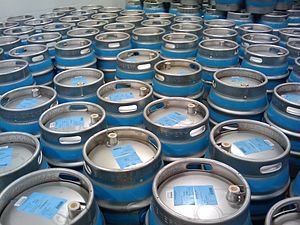
Back برميل (وحدة) Arabic Barrel (həcm vahidi) Azerbaijani Барэль (адзінка аб’ёму) Byelorussian Барэль BE-X-OLD Барел Bulgarian Barel BS Barril (unitat) Catalan Barel Czech Tønde (rummål) Danish Barrel German

A barrel is one of several units of volume applied in various contexts; there are dry barrels, fluid barrels (such as the U.K. beer barrel and U.S. beer barrel), oil barrels, and so forth. For historical reasons the volumes of some barrel units are roughly double the volumes of others; volumes in common use range approximately from 100 to 200 litres (22 to 44 imp gal; 26 to 53 US gal). In many connections the term drum is used almost interchangeably with barrel.
Since medieval times the term barrel as a unit of measure has had various meanings throughout Europe, ranging from about 100 litres to about 1,000 litres. The name was derived in medieval times from the French baril, of unknown origin, but still in use, both in French and as derivations in many other languages such as Italian, Polish, and Spanish. In most countries such usage is obsolescent, increasingly superseded by SI units. As a result, the meaning of corresponding words and related concepts (vat, cask, keg etc.) in other languages often refers to a physical container rather than a known measure.
In the international oil market context, however, prices in United States dollars per barrel are commonly used, and the term is variously translated, often to derivations of the Latin / Teutonic root fat (for example vat or Fass).[1]
In other commercial connections, barrel sizes such as beer keg volumes also are standardised in many countries.
- ^ Brown, Lesley (1993). The New shorter Oxford English Dictionary on Historical Principles. Oxford, UK: Clarendon. ISBN 0-19-861271-0.